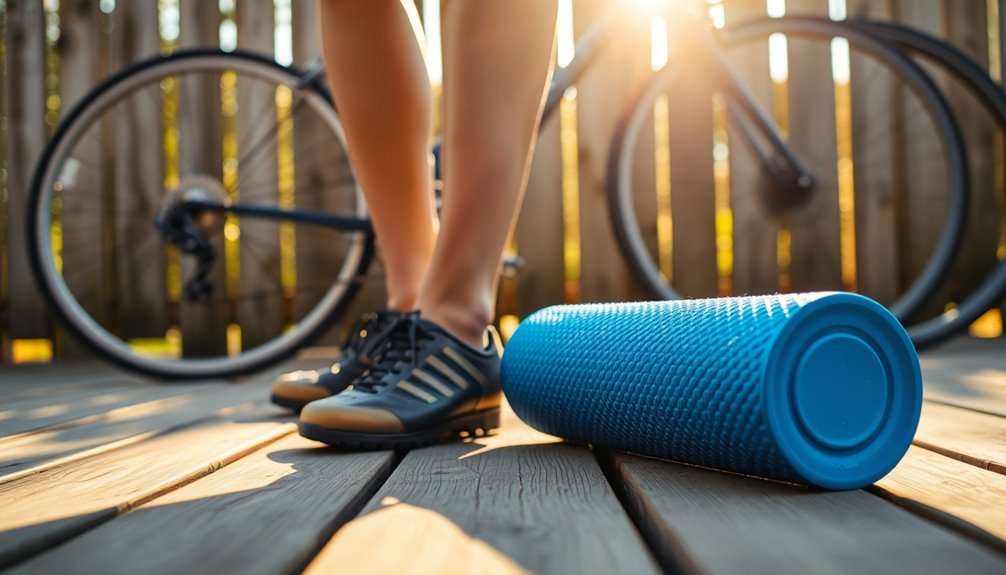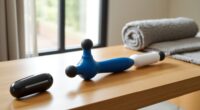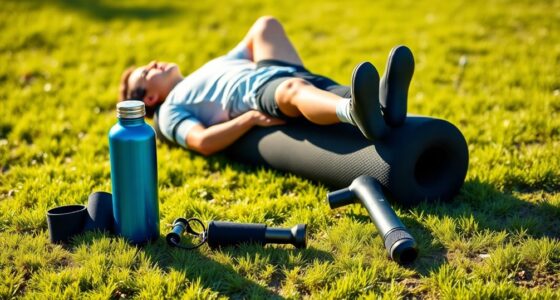To use a recovery foam roller effectively after a long ride, start by targeting key muscle groups like your quadriceps, hamstrings, and calves. Roll each area for 1-5 minutes, applying pressure in slow, controlled movements. Avoid rolling over joints or bony areas to prevent irritation. Hydrate afterwards, and listen to your body—stop if you feel pain beyond normal soreness. With the right techniques, you'll enhance recovery and boost performance. You'll discover more effective strategies ahead.
Key Takeaways
- Begin by warming up with dynamic stretches before foam rolling to enhance muscle recovery after a long ride.
- Target major muscle groups like quadriceps, hamstrings, glutes, and calves, spending 1-5 minutes on each.
- Use slow, controlled movements and maintain pressure on each area for 30-120 seconds to avoid injury.
- Stay hydrated post-session to support muscle recovery and alleviate soreness.
- Incorporate foam rolling 2-3 times a week, adjusting frequency based on your body's response to the recovery process.
Understanding Foam Rolling and Its Benefits
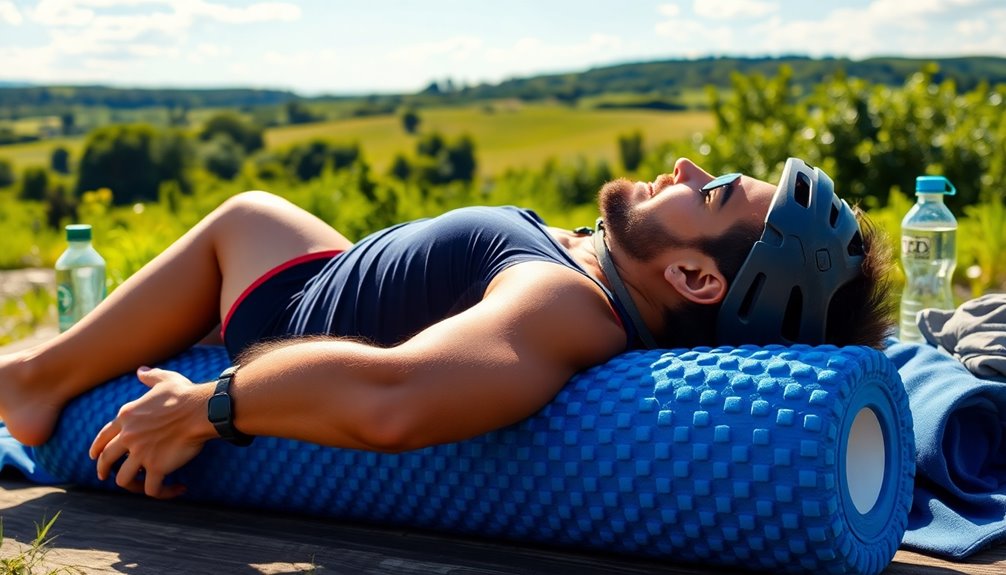
When you incorporate foam rolling into your routine, you're tapping into a powerful technique for muscle recovery and performance enhancement. This method, a form of myofascial release, helps alleviate muscle tension and improve the flexibility of your fascia.
Incorporating foam rolling into your routine enhances muscle recovery and flexibility, effectively easing tension and improving performance.
It's particularly effective for reducing muscle soreness after long rides. Research shows that spending just 20 minutes foam rolling post-exercise can greatly reduce delayed onset muscle soreness (DOMS) while enhancing athletic performance.
You'll notice a temporary increase in your range of motion and a reduction in muscle stiffness, making it easier to recover from tightness caused by prolonged periods in the saddle.
For best results, combine foam rolling with dynamic stretching and a proper warm-up routine.
Choosing the Right Foam Roller for You
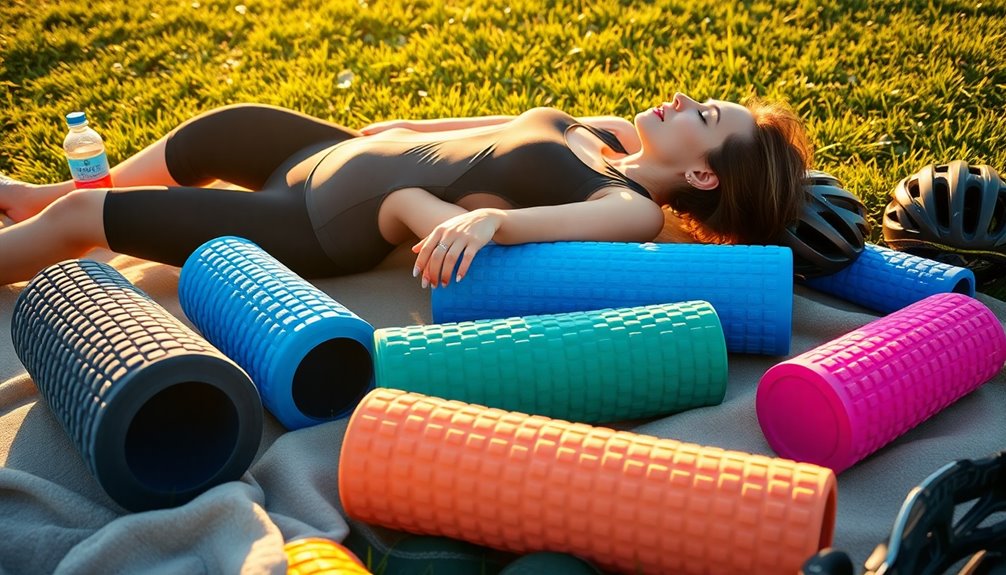
Selecting the right foam roller can greatly enhance your recovery routine. Here are some key factors to take into account:
- Densities: Medium density rollers suit most users, while firmer ones target deeper pressure.
- Size: Standard rollers have a diameter of 15 cm and come in lengths from 30 cm to 90 cm, fitting various needs.
- Trigger Point Massage: Knobbly rollers are perfect for addressing specific muscle tightness and soreness.
- Durability: Opt for hollow PVC core rollers for better durability and effectiveness on soft tissues.
When choosing the right foam roller, start with a basic model to see what works best for you before moving on to specialized options.
This way, you can guarantee that your recovery is both effective and enjoyable.
How to Use a Foam Roller After a Ride
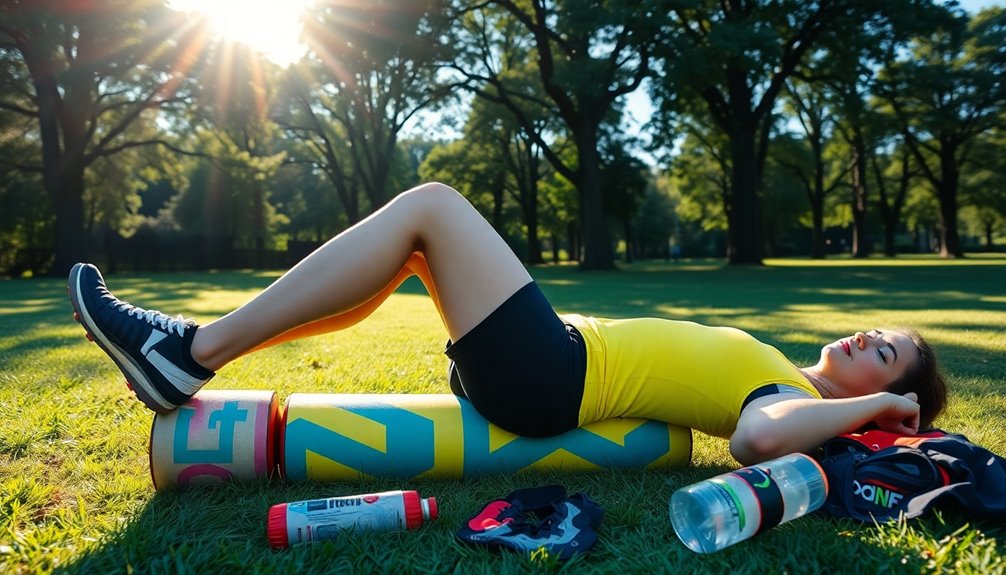
After a long ride, using a foam roller can considerably enhance your recovery process. Foam rolling post-exercise helps target key muscle groups, reducing muscle soreness and aiding recovery. Spend 1-5 minutes rolling each major muscle group, focusing on slow, controlled movements. Apply pressure for 30-120 seconds per area, ensuring you avoid bony areas and joints.
| Muscle Group | Duration |
|---|---|
| Quadriceps | 30-120s |
| Hamstrings | 30-120s |
| Glutes | 30-120s |
| Calves | 30-120s |
Hydrating after foam rolling is essential to support muscle recovery, so replenish fluids lost during your ride to enhance effective recovery.
Key Muscle Groups to Focus On
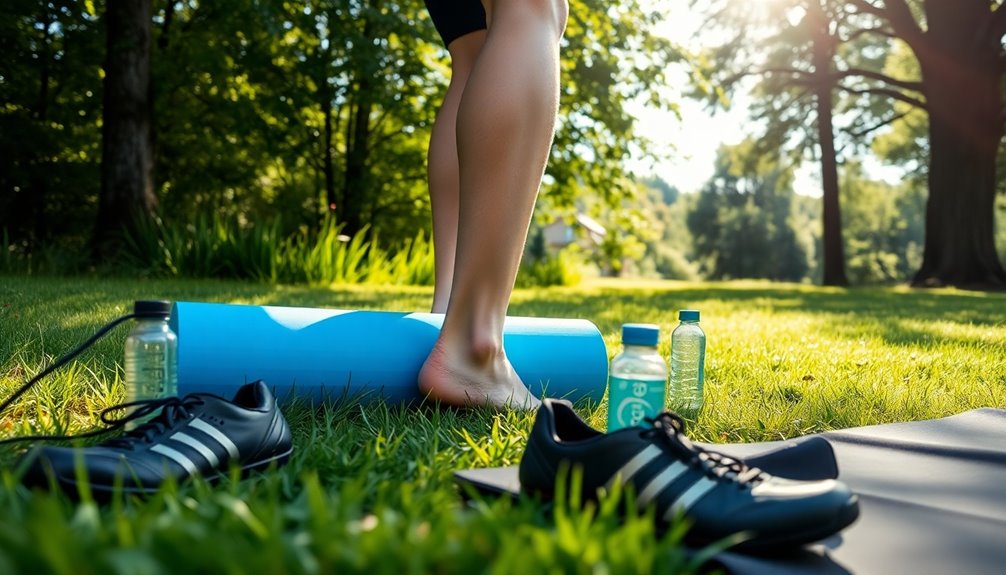
When you're using a foam roller, it's crucial to focus on key muscle groups like your quadriceps, hamstrings, and glutes.
Targeting these areas can help relieve tightness and improve your overall mobility.
Quadriceps Recovery Techniques
Foam rolling your quadriceps is an essential part of any post-ride recovery routine. It not only aids in muscle recovery but also enhances flexibility and reduces soreness.
Here are some effective techniques to incorporate:
- Position the foam roller under your thighs, rolling from just above the knee to the hip.
- Spend 1-2 minutes on each quadricep, targeting tender spots for up to 60 seconds.
- Use slow, controlled movements to help your muscle tissue relax and adapt.
- Foam roll 2-3 times a week to maintain flexibility and prevent tightness.
Glute Activation Exercises
To maximize your cycling performance and prevent injuries, incorporating glute activation exercises into your routine is essential. These exercises address common issues like underactive glutes from prolonged sitting and are vital for improving power output and stability on the bike.
| Exercise | Benefits | How to Perform |
|---|---|---|
| Glute Bridges | Enhances glute strength | Lie on your back, knees bent, lift hips. |
| Clamshells | Targets gluteus medius | Lie on your side, lift top knee, feet together. |
| Single-leg Deadlift | Improves balance and engagement | Stand on one leg, hinge at the hips to lower. |
Using a foam roller as a recovery tool can help reduce muscle soreness and address sore spots, further preventing muscle imbalances. Prioritize glute activation for ideal cycling results!
Hamstring Stretching Methods
Stretching your hamstrings is essential for maintaining flexibility and preventing injuries, especially for cyclists. To effectively use hamstring stretching methods, incorporate foam rolling into your routine.
Here are key techniques:
- Foam Roll: Sit with your legs extended, placing the foam roller under your thighs. Roll from behind the knee to the glutes for 1-5 minutes.
- Target Tender Points: Spend 30-60 seconds on each sensitive area to release tension in the soft tissue.
- Cross-legged Position: Enhance the stretch and target deeper muscle layers while rolling.
- Combine with Static Stretching: Follow foam rolling with static stretches for ideal muscle recovery and improved flexibility. Using a foam roller can also support muscle recovery by improving blood circulation and reducing soreness.
Common Mistakes to Avoid While Foam Rolling
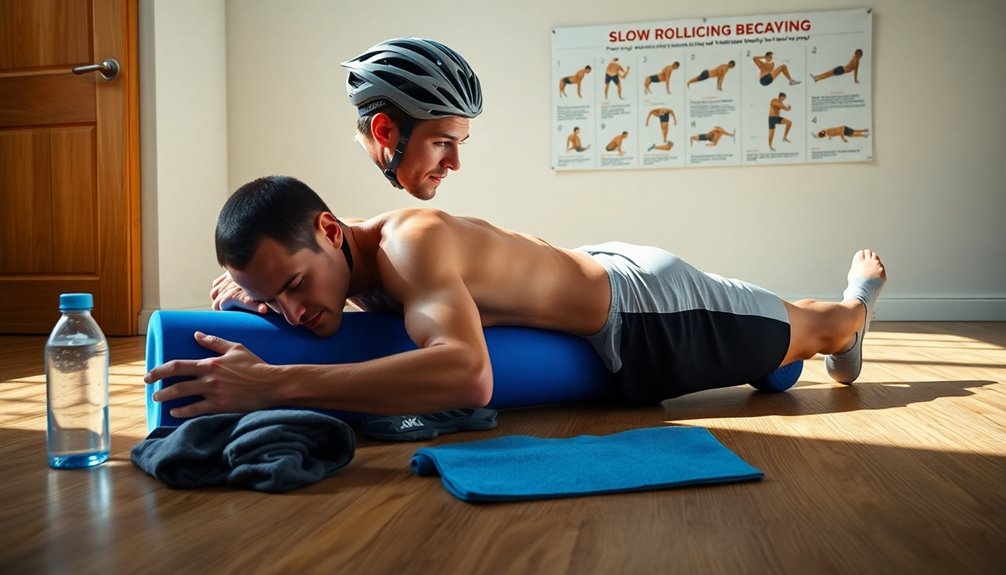
When foam rolling, it's essential to avoid rolling over joints or bony areas, as this can lead to irritation or injury.
Also, don't spend too long on each muscle group; stick to 10-20 seconds to prevent overstressing your tissues.
Keeping these tips in mind will help you get the most out of your foam rolling routine.
Rolling Over Joints
Rolling over joints can seem tempting, but it's crucial to steer clear of bony areas like the knees, elbows, and spine.
Focusing on these areas can lead to irritation and back pain. Instead, concentrate on the muscle belly where soft tissues are located.
Here are some common mistakes to avoid while foam rolling:
- Rolling directly over bony areas
- Applying excessive pressure on sensitive spots
- Using quick, uncontrolled movements
- Ignoring the importance of a broader routine
Additionally, consistent maintenance of your recovery routine can enhance overall performance and prevent injuries.
Excessive Rolling Duration
While foam rolling can be a beneficial part of your recovery routine, excessive rolling duration can lead to more harm than good.
Limiting your rolling to 10-20 seconds per muscle group is essential; otherwise, you risk causing muscle fatigue instead of relief. Aim for a total of 1-5 minutes per targeted area, practicing moderation to avoid micro-trauma that hinders recovery.
Remember to roll slowly, allowing your muscle tissue to relax and adapt. Rushing through can produce ineffective results and even lead to injury.
If you feel pain that wasn't there before, stop immediately to prevent exacerbating any existing conditions.
Keep your foam rolling sessions effective by respecting these time limits for ideal recovery.
Effective Foam Rolling Exercises for Recovery

To enhance your recovery routine, effective foam rolling exercises can target key muscle groups and alleviate tension. Here are some effective techniques to incorporate:
Enhance your recovery routine with effective foam rolling exercises that target key muscle groups and relieve tension.
- Glutes: Sit on the foam roller with one ankle crossed over the opposite knee, leaning toward the rolled side for 30-60 seconds.
- Hamstrings: Sit with legs extended, rolling from the back of your knees to glutes for 1-2 minutes.
- Quadriceps: Lie face down, rolling slowly from your hips toward your knees for 1-2 minutes.
- Calves: Sit with legs on the roller, crossing one leg over the other, and roll from the Achilles to just below the knee for 1-2 minutes.
Don't forget to also roll your lower back by pulling one knee to your chest while rolling for 1-2 minutes.
Tips for Incorporating Foam Rolling Into Your Routine

Incorporating foam rolling into your routine can greatly enhance your recovery process, especially if you focus on major muscle groups.
Target your quadriceps, hamstrings, glutes, and calves for 1-5 minutes, 2-3 times a week. Use a firm foam roller to apply adequate pressure, rolling slowly to promote effective myofascial release and reduce soreness post-ride.
Aim for 30 to 120 seconds on each muscle group, allowing 30-second breaks between passes. Combine foam rolling with dynamic stretching before rides and static stretching afterward to boost flexibility and improve overall performance.
Listen to your body, adjusting frequency and intensity as needed, and stop if you feel any pain beyond normal soreness during your sessions.
Frequently Asked Questions
How Do You Use a Foam Roller After a Long Run?
To use a foam roller after a long run, position it under your targeted muscle groups like quads, hamstrings, and calves.
Apply your bodyweight and roll slowly for 1-5 minutes on each area. Focus on the muscle belly, avoiding bony spots.
Spend about three seconds on each pass, and hold pressure on tender points for 30-60 seconds.
Make foam rolling part of your routine within 30 minutes post-run to enhance recovery and reduce soreness.
How Long Should I Foam Roll for Recovery?
You should foam roll for recovery between 1 to 5 minutes per muscle group.
Aim for about 30 to 120 seconds on each area, with each pass lasting around three seconds.
It's helpful to repeat this process one to three times, taking 30-second breaks in between for best results.
Incorporating foam rolling into your routine 2-3 times a week can really enhance your recovery and help prevent tightness.
How to Foam Roll After Cycling?
Imagine your muscles as tightly coiled springs after a long ride. To unwind them, grab your foam roller and start with your quadriceps, rolling slowly for 1-5 minutes.
Focus on the tension points, applying moderate pressure. Move to your hamstrings, glutes, and calves, spending about three seconds per pass.
Hold on tender spots for 30-60 seconds. Foam roll consistently, 2-3 times a week, to keep those springs relaxed and ready for your next adventure.
What Are Two Areas of Your Body You Should Avoid While Foam Rolling?
When foam rolling, you should avoid sensitive areas like your spine and knees. Rolling directly over these bony regions can cause irritation and injury.
Additionally, steer clear of your neck to prevent strain on your cervical spine. Instead, focus on muscle bellies for effective relief.
If you need to address tightness in those sensitive areas, gentle stretching or a targeted massage can be a safer option to alleviate discomfort.
Conclusion
Incorporating foam rolling into your post-ride routine can make a significant difference in your recovery. Did you know that studies show foam rolling can increase flexibility by up to 10% in just a few sessions? By targeting key muscle groups and avoiding common mistakes, you'll not only alleviate soreness but also enhance your performance for future rides. So, grab your foam roller and start rolling your way to a faster recovery and improved cycling experience!
